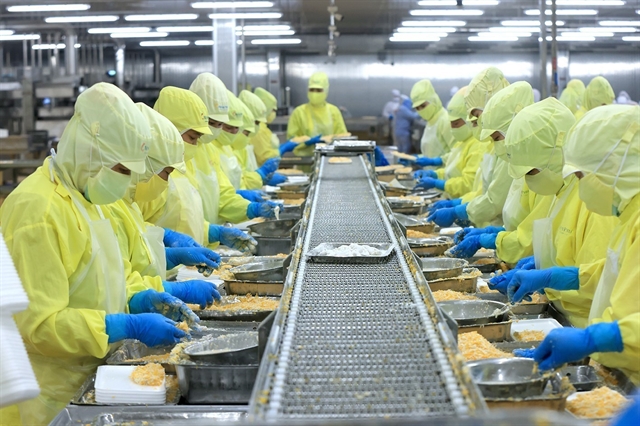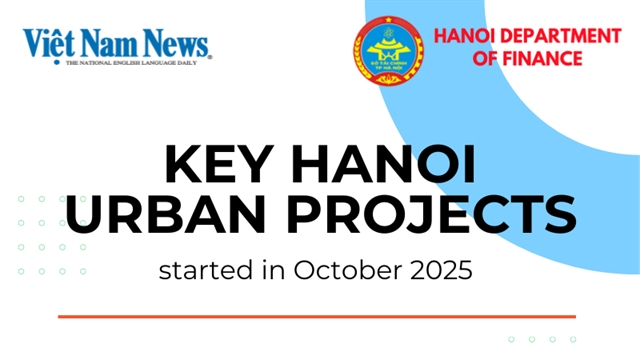 Environment
Environment

 |
| High-rise buildings in Hà Nội have nearly disappeared into the hazy sky. — VNA/VNS Photo Hoàng Hiếu |
HÀ NỘI — Environmental experts said that air pollution in Hà Nội is likely to persist through the end of April, longer than usual, due to uncontrolled emission sources and an ongoing lack of rainfall.
Typically, the worst of the air pollution situation eases significantly by the end of March, when the cold, dry winter ends.
On Friday morning, Hà Nội was shrouded in haze, with the sky veiled by a layer of PM2.5 fine dust, signalling poor air quality. According to the monitoring data from the Hà Nội Department of Agriculture and Environment, at 9am, most areas registered moderate air quality, with AQI (Air Quality Index) readings ranging from 59 to 91.
The highest AQI was recorded in Vân Hà Commune in Đông Anh District at 91, followed by An Khánh in Hoà Đức District at 87, and Minh Khai ward in Bắc Từ Liêm District at 67. Other areas hovered around 59–60.
Similar results were observed in data from the Ministry of Agriculture and Environment: 94 in Long Biên District’s Nguyễn Văn Cừ Street, 76 near Hà Nội University of Science and Technology, and 68 at Nhân Chính Park in Thanh Xuân District.
Hoàng Dương Tùng, an environmental expert, noted that the typical pollution season lasts from October to March. However, this year, due to reduced rainfall, pollution levels remain high and are likely to persist.
“With emission sources still unchecked and unfavourable weather conditions limiting pollutant dispersion, especially PM2.5 dust, the situation remains concerning,” he said.
Tùng added that while thunderstorms can temporarily reduce pollution, the scarcity of rain this year means conditions will likely remain poor until the end of April.
“In fact, recent data shows that air pollution in Hà Nội hasn't improved. It’s actually getting worse, which is deeply alarming,” he said.
A study by the Institute of Environmental Science and Technology at Hà Nội University of Science and Technology revealed that traffic emissions are the biggest contributor to fine dust pollution. Petrol and diesel vehicles account for 46 per cent of PM2.5 emissions, with motorbikes alone contributing over 90 per cent of the traffic-related volatile organic compounds. Following motorbikes, heavy trucks, buses, and light-duty vehicles are also significant polluters.
Industrial activity ranks as the second-largest source of emissions. Hà Nội is home to ten industrial zones and around 1,300 craft villages. Additionally, neighbouring provinces within a 50–100 km radius host major polluters, including coal-fired power plants in Hải Dương and Quảng Ninh, cement factories in Hoà Bình, Ninh Bình, and Hà Nam and fertiliser and chemical plants in Thái Nguyên and Phú Thọ.
Agricultural waste burning is the third-largest contributor, responsible for roughly 13 per cent of the air pollution in Hà Nội. The most severe pollution periods often coincide with the rice harvest seasons of Summer-Autumn and Winter-Spring when many farmers in suburban districts continue to burn rice straw in the fields.
Other sources such as construction, spontaneous waste burning, medical waste and various household activities collectively add about 10 per cent to the city’s pollution burden.
Hà Nội’s climate between October and April poses additional challenges. Large temperature differences between day and night, along with varying humidity, wind conditions and solar radiation, hinder the dispersion of pollutants, especially PM10 and PM2.5.
The Hà Nội Department of Agriculture and Environment cites multiple compounding factors. Over 40 per cent of the city’s population resides in urban areas. There are 17 industrial zones, 1,300 craft villages, and more than 7.8 million vehicles, not counting the additional 1.2 million from surrounding localities.
Each day, Hà Nội consumes about 80 million kWh of electricity and millions of litres of petrol and diesel. Combined with open burning of agricultural byproducts and unregulated waste disposal, these factors intensify the pollution problem.
Although Hà Nội has begun identifying major emission sources, the slow rollout of mitigation measures has led to sustained, high levels of pollution.
The Department of Environmental Pollution Control under the Ministry of Agriculture and Environment urges residents to monitor air quality regularly and take proactive steps to protect themselves from the harmful effects of pollution. — VNS


.jpg)

